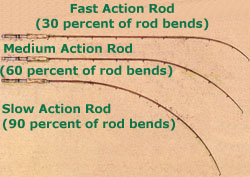Fly Fishing 101, Part 3
What is Action in Fly Rods?
Last time we talked about fly rods, various
weights of rods and their purposes. Differences in fly rods go
much further than the weights of the rods. Price is certainly a
consideration, but the one that gives fits to fly rodders is the action.
An article in Fly Rod and Reel magazine
a couple of years ago claimed that, " ... a six weight rod is a six weight rod,
they are all the same." All six weight rods cast a six weight line,
beyond that - WRONG. Absolutely false!
An accepted definition of Action is defined as
the relative resistance to bending as you move down the length
of a particular fly rod. Fast Action rods tend to resist
bending sooner than Slow Action rods. Thus
Slow Action rods tend to be more "whippy" and
will not cast as far as Fast action rods will cast.
Fast Action rods tend to generate higher line speeds
which make them easier to cast into the wind and for longer
distances. Between the two extremes, there are Moderate
Action rods. You need to cast any rod to determine if the
Action suits your style of casting.

We need a little history to make sense
of fly rod actions. The first so-called fly rods were wood,
and pretty crude. Fly lines were braided horse hair, not very
effective either. Eventually rods evolved to cane, then split
cane into intricately designed casting tools. Works of
art - then and now.
Split bamboo was the ultimate fly rod.
My grandfather had a steel, hexagon telescopic fly rod. It was
heavy and the state of the art in non-bamboo rods. I learned fly
casting on that rod.
During World War II, many new products
hit the market. Fiberglass was one of them. So was PVC. Dacron
and Nylon came out of the war effort too. Lots of innovations that
ended up in the fly fishing world.
Fiberglass fabric was wrapped on a wood rod.
Epoxy finished and the fiberglass rod was on the market. When the
inventors figured out how to do away with the wood center the first
hollow rods were born.
Considering the choices available at the time,
either split bamboo or steel, the fiberglass rods were designed to
copy bamboo. Fake bamboo rods. With a similar action ... as
close as possible. Cane fly rods have a soft to moderate action.
Some fiberglass rods were very soft, (we call them "noodley")
the longer the rod, the more noodley it became.
Follow through a couple more decades
into the space age and we find the fly rod industry taking advantage
of new technology again. This time it is graphite and boron. Almost
any material can be formed into threads of some sort. Once it's thread,
it can be woven into fabric ... just like fiberglass which appeared in
drapes, patching material for cars and boats - and flyrods. Boron
was tried and rejected because it was considerably heavier than graphite
without additional strength.
Here comes the catch. Those companies who
had been making fiberglass rods had everything set up to make those
rods to imitate or at least be similar to bamboo. Now there is a new
material. What will happen?
Most companies had their machinery,
mandrills (steel forms the fabric is wrapped on to make the blanks,)
and their reputations established. If you bought one of their rods
you knew by reputation how the rod would feel.
Some companies replaced part of the
threads in the fabric with graphite. That made the rods lighter,
but only slightly changed the action.
New companies had the option to make
the same slow or medium action rods already on the market - or
to do something entirely different. That's where faster action rods
started.
Fast rods that are lighter in your hand,
use more of the tip to propel the line, and (if cast correctly) do
the work for you. One of the major advantages in fast rods is
the person casting it does less work. So you aren't as tired
as quickly.
Fast rods are primarily designed with the
butt and middle sections built to play the fish, the top one third
to cast the line. That does make the tip section (which is tiny
compared to rods just a few years ago) vulnerable to breakage
if the rod is used incorrectly when playing or landing a fish.
Bottom line? What do you want to fish for?
Under what conditions? What can you afford? If you are casting
well enough to get the fly where you want it most of the time, you
also probably have developed a style - a method that is comfortable
for you.
From one who has been fishing for some years,
a word of encouragement. There is no such thing as a bad graphite fly
rod. All of us would have thought we had gone to heaven if we had
been offered any of the rods on the market today 25 years ago. The
fly rod industry has made giant leaps improving our sport.
Match the action of the rod, and the price, to
what works for you. Final word of wisdom: Don't ever buy a
rod you have not cast.
Stop by the Chat Room and meet some fellow anglers. It is a nice
bunch of people - always willing to help new fly anglers! Or just share your
fishing adventures. Fair skys and tight lines, ~ DB
Have a question? Email me!
Beginners Archives
|